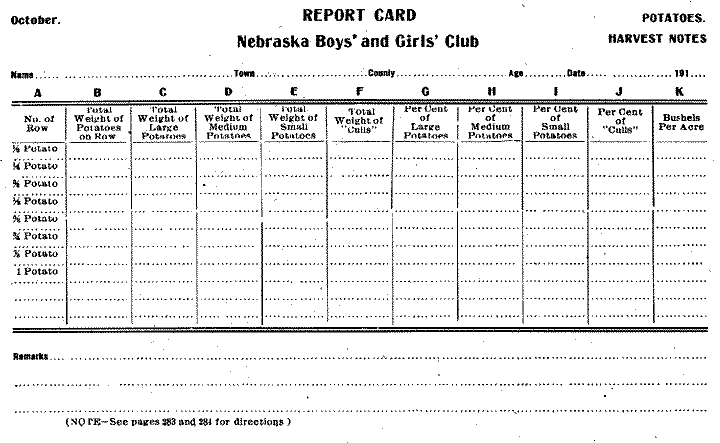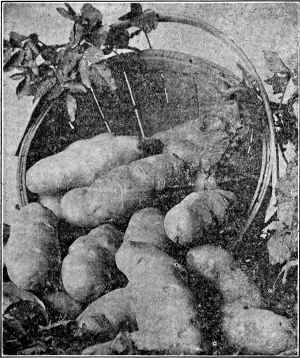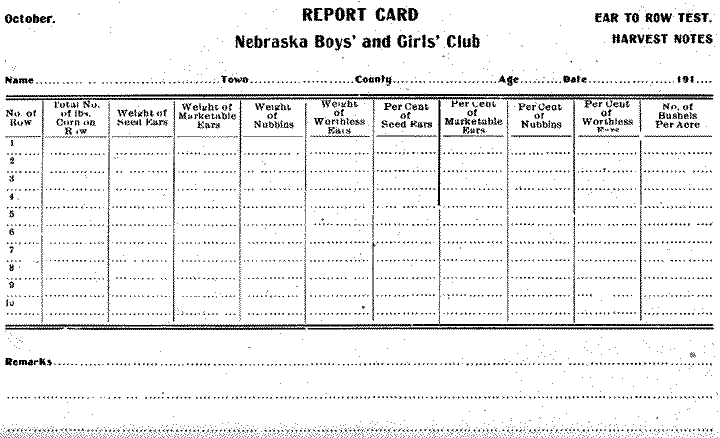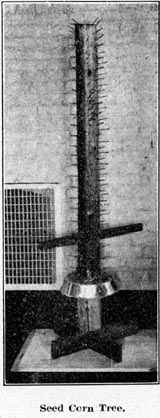
NEGenWeb
Project
Resource Center
Schools
|
|
285 |

|
286 |
|

To Find the Total Suckers--Count all the suckers in each row and write the number.
To Find the Total Barren Stalks--Count all the barren stalks in each row and write the number.
To Find the Total Smutted Stalks--Count all stalks affected by smut in each row and write the number.
To Find the 0 Stalk Hills--Count from the record (each row) all the hills containing no stalks.
To Find the 1 Stalk Hills--Count from the record (each row) all the hills having one stalk.
To Find the 2 Stalk Hills--Count from the record (each row) all the hills having two stalks.
To Find the 3 Stalk Hills--Count from the record (each row) all the hills having three stalks.
To Find the Total Stalks in Row--Multiply the 3 stalk hills in each row by 3, and the 2 stalk hills in each row by 2. Add the products obtained by this multiplication and the number of hills having 1 stalk in each row. The number obtained from this addition will give the total stalks in the row.
|
|
287 |
To Find Per Cent Suckers--Divide the total number of suckers in each row by the total number of stalks in the same row.
To Find Per Cent Barren Stalks--Divide the total number of barren stalks in each row by the total number of stalks in the same row.
To Find the Per Cent Smutted Stalks-Divide the total number of smutted stalks in each row by the total number of stalks in the same row.
To Find Per Cent Stand--Divide the total stalks in each row by the number there should be.
TO THOSE ENTERED IN THE EAR TO ROW TEST.
It is now fall. You have noted the difference in growth between the ten ears of corn planted last spring. You have seen how that one ear produced ears high on the stalk, while another produced the ear close to the ground. You have noticed considerable difference in the per cent of barren stalks, suckers, smutted stalks, per cent stand, etc., produced on each row. Now we have come to the most Interesting and important step in our whole season's work; we will find out which ear yielded the most corn of the best quality. This can only be done by following the instructions closely and paying minute attention to the definitions of seed ear, marketable ear, nubbin and worthless ear. The equipment you will need is a husking peg, a pair of reliable scales and a basket or box in which to weigh the corn from each row. When you enter the total weight of corn on the report card, be sure you subtract each time the weight of the box, basket or sack in which the corn is weighed. If this is not done, your results will not be correct.
Be sure to husk all the ears in the row, whether large, small or worthless. If an ear is found lying between two rows, look around and see what row the stalk it came from is in. Then put it back in the proper row so that you will not get it mixed with corn from another row.
1. Seed ear: An car of corn showing the requirements of a good seed ear.
2. Marketable Ear: An ear not good enough for seed but well matured, round and in such condition that it will sell well on the market.
3. Nubbin. A short, stunted ear, less than five inches long or an ear having kernels on but one side.
4. Worthless Ear: An ear with but few kernels on the cob, one that is moldy, rotten or in some other way useless as feed.
|
288 |
|
Do not weigh closer than one-fourth pound.
1. Total Weight of Pounds of Corn on Row: Found by husking every ear on the row, whether good or not, and weighing on a reliable scale.
2. Weight of Seed Ears: Found by sorting out and weighing all the nubbins on the row.
3. Weight of Marketable Ears: Found by sorting out and weighing all the marketable ears on the row.
4. Weight of Nubbins: Found by sorting out and weighing all the nubbins found on the row.
5. Weight of Worthless Ears: Found by sorting out and weighing all the worthless ears on the row.
.6. Per Cent of Seed Ears: Found by dividing the weight of seed ears by the total number of pounds of corn on the row.
7. Per Cent of Marketable Ears: Found by dividing the weight of marketable ears by the total number of pounds of corn on row.
8. Per Cent of Nubbins. Found by dividing the weight of nubbins by the total number of pounds of corn on the row.
9. Per Cent of Worthless Ears: Found by dividing the weight of the worthless ears by the number of pounds of corn on the row.
10. Number of bushels per acre: This is the most important point of all. Found by dividing the number of pounds of corn on the row by 100, the number of hills in the row. The answer will be the number of pounds corn on one hill. Multiply this number by 3556, (the number of hills on an acre when planted 3 feet 6 inches each way). The answer will be the number of pounds of corn produced on 3556 hills or one acre. Divide this number by 75, the number of pounds in a bushel at this time of year. The result is the number of bushels per acre.
Note: The contestant will find it advisable to reduce all fractions to decimals when figuring percentage. Do not carry any problems out farther than one place to the right hand side of the decimal point.
FIRST ANNUAL NEBRASKA CORN HUSKING CONTEST.
Nebraska Boys' and Girls' Club.
(Rules and Regulations.)
1. Any person under twenty-one years of age is eligible to this contest.
2. He must husk eight hours in the same day, four hours in the forenoon and four in the afternoon.
3. He must stop one hour at noon.
|
|
289 |
4. He must use the same team the entire day.
5. He may have no person, other than himself, drive or lead the team attached to the wagon in which he is husking.
6. He shall use a common farm wagon.
7. He may husk in any field he sees fit, whether his own or some other.
8. He may use any make of husking-peg, hook or other device attachable to the hand or wrist.
9. He may use gloves, cloth mittens or any other protection to his hands he wishes.
10. He must husk all ears more than three inches long as he goes along, whether on the ground or attached to the stalks.
11. Practically all husks must be removed from the ears before thrown into the wagon. Not more than one husk to three ears will be allowed.
12. He may use no endgate more effective than the ordinary "Boss" endgate.
13. He must unload his load of corn without the assistance of another person.
14. He must unload his corn with a scoop-shovel.
15. He must have his loads unloaded before the expiration of the eight hours mentioned in (2).
16. The affidavit as indicated, must be filled out and sent to the county superintendent, who will forward the same to the state superintendent.
|
290 |
|

|
|
291 |
(To be filled in before a Notary Public.)
I, . . . . . . . . . . . . . . . . . . . . residing In the County of . . . . . . . . . . . . . . . . . . . . and the State of . . . . . . . . . . . . . . . . . . . . being first duly sworn, depose and say, that I did on the day of . . . . . . . . . . . . . . . . . . . . 19 . . .husk . . . . . . . . . . . pounds, making . . . . . . bushels of corn according to the Rules and Regulations printed on page 27 of this bulletin.. . . . . . . . . . . . . . . . . . . . .
Age of contestant . . . . . . . . . . . . . .years. Address of contestant:
Town . . . . . . . . . . . . . . . . . . . . County . . . . . . . . . . . . . . .
State of Nebraska, . . . . . . . . . . . . . . . .County
On this day of . . . . . . . . . . . . . . . . . . . . 19... before me, a . . . . . . . . . . . . . . . . . . . . . . . . . . . . . . . . . for and residing in said County came ............................................................................................... who is personally known to me to be the identical person whose name is affixed to the foregoing Affidavit.
Witness my hand and seal at . . . . . . . . . . . . . . . . . . . .on the date last above mentioned.
. . . . . . . . . . . . . . . . . . . . . . . . . . . . . . . . . . . . . . . .
. . . . . . . . . . . . . . . . . . . . . . . . . . . . . . . . . . . . . . . .
I, . . . . . . . . . . . . . . . . . . . . . . . . . . . . . . . . . . . . . . . . County Superintendent of Public Instruction of . . . . . . . . . . . . . . . . . . . .County Nebraska, certify that to the extent of my knowledge and belief the accompanying report of
. . . . . . . . . . . . . . . . . . . . . . . . . . . . . . . . . . . . . . . . , a contestant in the Nebraska corn husking contest is true and correct in every particular.
. . . . . . . . . . . . . . . . . . . . . . . . . . . . . . . . . . . . . . . .
County Superintendent.
Date ......................1910.
|
292 |
|

 |
 |
 |
 |
|
© 2003 for the NEGenWeb Project by Ted & Carole Miller |
|||